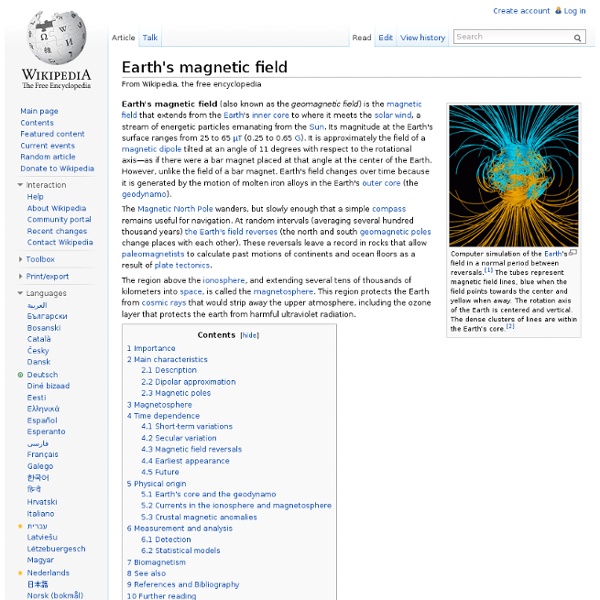Swarm reveals Earth’s changing magnetism -- ScienceDaily
The first set of high-resolution results from ESA's three-satellite Swarm constellation reveals the most recent changes in the magnetic field that protects our planet. Launched in November 2013, Swarm is providing unprecedented insights into the complex workings of Earth's magnetic field, which safeguards us from the bombarding cosmic radiation and charged particles. Measurements made over the past six months confirm the general trend of the field's weakening, with the most dramatic declines over the Western Hemisphere. But in other areas, such as the southern Indian Ocean, the magnetic field has strengthened since January. The latest measurements also confirm the movement of magnetic North towards Siberia. These changes are based on the magnetic signals stemming from Earth's core. This will provide new insight into many natural processes, from those occurring deep inside our planet to space weather triggered by solar activity.
Magnetic dipole
Dipole moment m. The magnetic field around any magnetic source looks increasingly like the field of a magnetic dipole as the distance from the source increases. External magnetic field produced by a magnetic dipole moment[edit] An electrostatic analogue for a magnetic moment: two opposing charges separated by a finite distance. The magnetic field of a current loop. In classical physics, the magnetic field of a dipole is calculated as the limit of either a current loop or a pair of charges as the source shrinks to a point while keeping the magnetic moment m constant. with 4π r2 being the surface of a sphere of radius r; Alternatively one can obtain the scalar potential first from the magnetic pole limit, and hence the magnetic field strength (or strength of the H-field) in ampere-turns per meter is The magnetic field is symmetric under rotations about the axis of the magnetic moment. Internal magnetic field of a dipole[edit] These fields are related by B = 0(H+M), where is the magnetization.
Plate tectonics
The tectonic plates of the world were mapped in the second half of the 20th century. Remnants of the Farallon Plate, deep in Earth's mantle. It is thought that much of the plate initially went under North America (particularly the western United States and southwest Canada) at a very shallow angle, creating much of the mountainous terrain in the area (particularly the southern Rocky Mountains). Plate tectonics (from the Late Latin tectonicus, from the Greek: τεκτονικός "pertaining to building") is a scientific theory that describes the large-scale motion of Earth's lithosphere. The lithosphere, which is the rigid outermost shell of a planet (on Earth, the crust and upper mantle), is broken up into tectonic plates. Key principles The outer layers of the Earth are divided into the lithosphere and asthenosphere. The key principle of plate tectonics is that the lithosphere exists as separate and distinct tectonic plates, which ride on the fluid-like (visco-elastic solid) asthenosphere.
Magnetic moment
The magnetic moment of a magnet is a quantity that determines the torque it will experience in an external magnetic field. A loop of electric current, a bar magnet, an electron, a molecule, and a planet all have magnetic moments. Definition[edit] The magnetic moment is defined as a vector relating the aligning torque on the object from an externally applied magnetic field to the field vector itself. The relationship is given by [1] where is the torque acting on the dipole and is the external magnetic field, and m is the magnetic moment. This definition is based on how one would measure the magnetic moment, in principle, of an unknown sample. Units[edit] Where A = Ampere m = meter J = Joule In the CGS system, there are several different sets of electromagnetism units, of which the main ones are ESU, Gaussian, and EMU. and EMU CGS or Gaussian-CGS Where statA = statAmpere cm = centimeter erg = erg abA = Abampere Two representations of the cause of the magnetic moment[edit] Current loop representation[edit]
Earth l Earth facts, pictures and information.
Earth is the third planet from the Sun and the fifth largest: Planet Profile orbit: 149,600,000 km (1.00 AU) from Sundiameter: 12,756.3 kmmass: 5.972e24 kg History of Earth Earth is the only planet whose English name does not derive from Greek/Roman mythology. It was not until the time of Copernicus (the sixteenth century) that it was understood that the Earth is just another planet. Earth, of course, can be studied without the aid of spacecraft. The Earth is divided into several layers which have distinct chemical and seismic properties (depths in km): 0- 40 Crust 40- 400 Upper mantle 400- 650 Transition region 650-2700 Lower mantle 2700-2890 D'' layer 2890-5150 Outer core 5150-6378 Inner core The crust varies considerably in thickness, it is thinner under the oceans, thicker under the continents. Most of the mass of the Earth is in the mantle, most of the rest in the core; the part we inhabit is a tiny fraction of the whole (values below x10^24 kilograms): Earth's Satellite Open Issues
Multipole expansion
Expansion in spherical harmonics[edit] Most commonly, the series is written as a sum of spherical harmonics. Thus, we might write a function as the sum Here, are the standard spherical harmonics, and are constant coefficients which depend on the function. represents the monopole; represent the dipole; and so on. Here, the represent the components of a unit vector in the direction given by the angles and , and indices are implicitly summed. is the monopole; is a set of three numbers representing the dipole; and so on. In the above expansions, the coefficients may be real or complex. In the multi-vector expansion, each coefficient must be real: For describing functions of three dimensions, away from the coordinate origin, the coefficients of the multipole expansion can be written as functions of the distance to the origin, —most frequently, as a Laurent series in powers of . , from a source in a small region near the origin, the coefficients may be written as: Applications of multipole expansions[edit]



